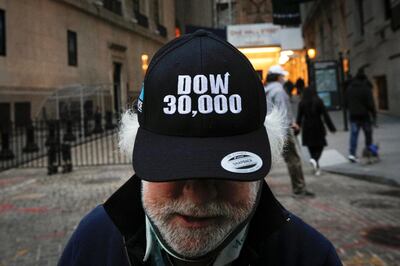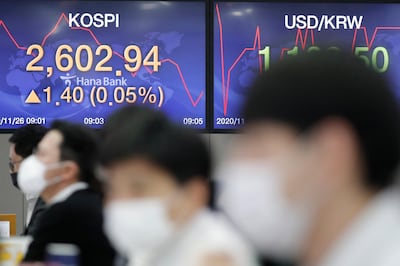While 2020 caused the global economy’s most severe economic contraction in decades and triggered vast monetary and fiscal support packages, next year could be very different for investors, according to Lombard Odier.
With the imminent distribution of Covid-19 vaccines across the globe, the Swiss investment bank said mass vaccinations, public health measures and “extraordinary government spending and monetary policy support” should accelerate the economic recovery.
“This vaccine will be a game changer in controlling and containing the pandemic,” said Samy Chaar, chief economist at Lombard Odier. “What we know from 2020 is that when we contain the pandemic economic activity catches up extremely quickly.”
Mr Chaar pointed to Asia, where the economic catch-up in the third quarter of the year was extremely visible once the restrictions were removed.
While Europe has lost about 7 per cent of output this year when compared to last year, the US will only lose 3.5 per cent, and China is expected to be 2 per cent above the output levels seen at the end of last year.
As restrictions are lifted, Mr Chaar expects the US economy to recover its pre-Covid output in the second or third quarter while Europe might need to wait until the first quarter of 2022.
Mr Chaar said this pattern of uneven economic catch-up will also affect certain sectors with heavily-hit industries, such as leisure, tourism and transport taking longer to recover, while housing, manufacturing and trade are set to outperform.
Equities have been on a roller coaster this year, with global markets suffering a sharp contraction in March at the height of the pandemic, before recovering over the course of the year.
The Dow Jones Industrial Average traded above 30,000 points for the first time on Tuesday, buoyed by news of Covid-19 vaccines and the imminent accession to the Oval Office of Joe Biden.
However, the rally stalled on Thursday as European stocks dipped and US futures were mixed after sobering economic data deflated the demand for global risk assets and sentiment turned cautious.
“Twelve months ago, few could have imagined such a tumultuous year ahead. While 2020 will cast a long shadow, we expect next year to deliver a rapid and robust global recovery,” Lombard Odier said.
Here, Stéphane Monier, the bank’s chief investment officer, outlines his 10 investment convictions for next year.
1. Stay invested in risk assets
Positive vaccine developments and continued monetary and fiscal support are set to accelerate the economic recovery.
“Corporate earnings offered a positive third-quarter surprise, and with interest rates expected to stay low, equities should continue to rally with fixed income carry strategies still providing returns,” he said.
2. Maintain a diversified portfolio
Mr Monier warns the vaccine-fuelled recovery will not be a linear process. “The low-yield environment makes traditional portfolio stabilisers, such as domestic government bonds, less efficient,” he said.
As a result, he favours holding a diversified set of hedges ranging from US treasuries, or Chinese government bonds, to gold and the yen.
“Such assets can evolve independently from the equity risk that we want to cushion, and therefore need tactical management,” he said.
3. Hold on to gold, for now
Short-term uncertainties should keep gold prices trading in the $1,850 to $2,000 per ounce range next year, which offers investors an efficient hedge against equity volatility.
"A depreciating US dollar may help the physical demand for gold, but we expect financial demand to remain the strongest price driver," said Mr Monier.
Later in the year, once a recovery is in place, real rates are back to normal levels and investors have once again increased their exposure to risky assets, he expects gold prices to head towards $1,600.
What are our top 10 #investment convictions for next year? While COVID-19 vaccines will be a game changer & economic recoveries will be uneven, 2021 will certainly offer #opportunities for investors. Discover more here, with our CIO Private Bank. https://t.co/OFv8NfCaHh
— Lombard Odier (@lombardodier) November 24, 2020
4. Use carry strategies to generate yield
While the traditional portfolio hedging properties of government fixed income assets may be reduced given the current low yield levels, corporate credit should continue to benefit as investors seek returns.
This dynamic, in an environment of low inflation and anchored monetary policy, will continue, said Mr Monier with emerging market hard currency bonds looking “particularly attractive”.
5. Capture the recovery with balanced cyclical and growth stocks
The vaccine news eliminated the worst-case scenario for the recovery and made cyclical stocks, including small capitalisations, more compelling, said Mr Monier.
“That sets the stage for a partial catch-up in valuations and earnings in industrials, construction, materials, financials and energy stocks, as well as in Europe’s markets where these sectors are predominant,” said Mr Monier.
While all these sectors were hard hit by the pandemic, they tend to perform early in an economic upswing.
“We expect demand for quality names in healthcare and technology to continue in 2021, especially after the initial catch-up phase, as their fundamentals remain strong,” he said.
6. Don’t miss out on Asian equities
China’s economic recovery and more domestic-driven economy makes the country’s equity markets increasingly uncorrelated to the rest of the world’s equity indices.
“The country will also be one of the earliest beneficiaries from any thawing of trade relations with the US under a Biden administration,” said Mr Monier.
Other emerging markets should also see prospects improve on the back of the global trade revival, following a two-year contraction.
7. Invest in the real economy
Mr Monier advises private investors to make their portfolios more resilient by putting capital to work in non-listed companies.
“Investment activity in this market slowed during the pandemic,” he said. “Lower company valuations for many investment targets and record levels of industry cash are now opening significant opportunities.”
This capital should help companies recover and generate sustainable growth, he said.
Infrastructure assets are poised to benefit from massive levels of government pandemic spending as real estate markets, changing commuting and working patterns shift demand away from commercial property in the short run.
8. Expect the US dollar to weaken
Despite the US dollar's 12 per cent drop since March 2020, the currency remains overvalued and still includes some of the risk factored into US electoral chaos.
“Joe Biden’s presidential victory represents a return to normality, which, together with progress on vaccines, should allow global growth and trade to recover,” said Mr Monier.
9. Expose portfolios to improving trade conditions with emerging currencies
Rebounding emerging market growth, vaccine hopes and lower extreme risks for the weakest emerging currencies should drive the JP Morgan Emerging Market Currency Index higher in the first quarter of 2021.
Mr Monier advises investing in currencies that enjoy a valuation cushion, good external balances and exposure to a world trade recovery such as the Chinese yuan, South Korean won, Czech koruna and Chilean peso.
10. Sustainability will be a key driver of portfolio performance
All economic activity depends on natural resources and yet the world’s current economic model is unsustainably wasteful.
Companies with ambitious and sustainable solutions in every sector and industry are driving the transition to cleaner, leaner, inclusive and circular alternatives, Mr Monier said.
He favours companies developing new technologies and products to curb high CO2 emissions and sees untapped investment opportunities in firms adopting regenerative approaches to the planet’s natural capital.







